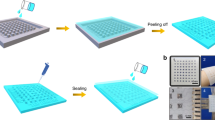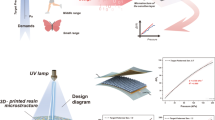Abstract
We introduce a new concept of a flexible tactile sensor array capable of sensing contact force and position with high performance and high spatial resolution. The proposed sensor array consists of a sub-millimetre-size bar-shaped semi-conductor strain gage array attached to a thin and flexible printed circuit board covered by stretchable elastomeric material on both sides. This design incorporates the benefits of both materials, the semiconductors’ high performance and the polymer’s mechanical flexibility and robustness, while overcoming the drawbacks of those two materials. For this paper, we have tested the feasibility of using this concept to develop high performance flexible tactile sensors; we fabricated a 5 × 5 sensor array of tactile sensors with commercial semiconductor strain gages. Each sensor element shows the good performances in terms of resolution better than 0.4 kPa, repeatability less than 1%, hysteresis less than 3%, zero return error less than 1%, and no observable drift over time.
Similar content being viewed by others
References
Aldhous, P., “Reaching for the next generation of prosthetic arms,” New Sci., Vol. 190, No. 2553, pp. 28–29, 2006.
Rosenwald, M., “A lifelike prosthetic arm,” Technol. Rev., Vol. 112, No. 3, pp. 76–77, 2009.
Dahiya, R. S., Metta, G., Valle, M., and Sandini, G., “Tactile sensingfrom humans to humanoids,” IEEE T. Robot., Vol. 26, No. 1, pp. 1–20, 2010.
Maheshwari, V. and Saraf, R., “Tactile devices to sense touch on a par with a human finger,” Angew. Chem. Int. Ed., Vol. 47, No. 41, pp. 7808–7826, 2008.
Schostek, S., Ho, C. N., Kalanovic, D., and Schurr, M. O., “Artificial tactile sensing in minimally invasive surgery — A new technical approach,” Minimal. Invasiv. Ther., Vol. 15, No. 5, pp. 296–304, 2006.
Yousef, H., Boukallel, M., and Althoefer, K., “Tactile sensing for dexterous in-hand manipulation in robotics — A review,” Sensor Actuat. A-Phys., Vol. 167, No. 2, pp. 171–187, 2011.
Phung, T. C., Ihn, Y. S., Koo, J. C., and Choi, H. R., “Edge identification of a small object through a low-resolution tactile sensor array,” Int. J. Precis. Eng. Manuf., Vol. 11, No. 2, pp. 247–254, 2010.
Kim, E.-H., Lee, S.-W., and Lee, Y.-K., “A dexterous robot hand with a bio-mimetic mechanism,” Int. J. Precis. Eng. Manuf., Vol. 12, No. 2, pp. 227–235, 2011.
Gellis, M. and Pool, R., “Two point discrimination distances in the normal hand and forearm: application to various methods of fingertip reconstruction,” Plast. Reconstr. Surg., Vol. 59, No. 1, pp. 57–63, 1977.
Johnson, K. O. and Phillips, J. R., “Tactile spatial resolution. I. Two-point discrimination, gap detection, grating resolution, and letter recognition,” J. Neurophysiol., Vol. 46, No. 6, pp. 1177–1191, 1981.
Ádám, M., Mohácsy, T., Jónás, P., Dücso, C., Vázsonyi, E., and Bársony, I., “CMOS integrated tactile sensor array by porous Si bulk micromachining,” Sensor Actuat. A-Phys., Vol. 142, No. 1, pp. 192–195, 2008.
Kane, B. J., Cutkosky, M. R., and Kovacs, G. T. A., “CMOScompatible traction stress sensor for use in high-resolution tactile imaging,” Sensor Actuat. A-Phys., Vol. 54, No. 1–3, pp. 511–516, 1996.
Mei, T., Li, W. J., Ge, Y., Chen, Y., Ni, L., and Chan, M. H., “Integrated MEMS three-dimensional tactile sensor with large force range,” Sensor Actuat. A-Phys., Vol. 80, No. 2, pp. 155–162, 2000.
Engel, J., Chen, J., Fan, Z., and Liu, C., “Polymer micromachined multimodal tactile sensors,” Sensor Actuat. A-Phys., Vol. 117, No. 1, pp. 50–61, 2005.
Hwang, E. S., Seo, J. H., and Kim, Y. J., “A polymer-based flexible tactile sensor for both normal and shear load detections and its application for robotics,” J. Microelectromech. S., Vol. 16, No. 3, pp. 556–563, 2007.
Kim, K., Lee, K. R., Kim, W. H., Park, K. B., Kim, T. H., Kim, J. S., and Park, J. J., “Polymer-based flexible tactile sensor up to 32 × 32 arrays integrated with interconnection terminals,” Sensor Actuat. A-Phys., Vol. 156, No. 2, pp. 284–291, 2009.
Kwon, H.-J. and Choi, W.-C., “Design and fabrication of a flexible three-axial tactile sensor array based on polyimide micromachining,” Microsyst. Technol., Vol. 16, No. 12, pp. 2029–2035, 2010.
Castellanos-Ramos, J., Navas-González, R., Macicior, H., Ochoteco, E., and Vidal-Verdú, F., “Tactile sensors based on conductive polymers,” Microsyst. Technol., Vol. 16, No. 5, pp. 765–776, 2010.
Shimojo, M., Namiki, A., Ishikawa, M., Makino, R., and Mabuchi, K., “A tactile sensor sheet using pressure conductive rubber with electrical-wires stitched method,” IEEE Sens. J., Vol. 4, No. 5, pp. 589–596, 2004.
Someya, T., Kato, Y., Sekitani, T., Iba, S., Noguchi, Y., Murase, Y., Kawaguchi, H., and Sakurai, T., “Conformable, flexible, large-area networks of pressure and thermal sensors with organic transistor active matrixes,” P. Natl. Acad. Sci. USA, Vol. 102, No. 35, pp. 12321–12325, 2005.
Someya, T., Sekitani, T., Iba, S., Kato, Y., Kawaguchi, H., and Sakurai, T., “A large-area, flexible pressure sensor matrix with organic field-effect transistors for artificial skin applications,” P. Natl. Acad. Sci. USA, Vol. 101, No. 27, pp. 9966–9970, 2004.
Bloor, D., Graham, A., Williams, E. J., Laughlin, P. J., and Lussey, D., “Metal-polymer composite with nanostructured filler particles and amplified physical properties,” Appl. Phys. Lett., Vol. 88, No. 10, pp. 102–103, 2006.
Choi, B., Choi, H. R., and Kang, S., “Development of tactile sensor for detecting contact force and slip,” IEEE IRS/RSJ International Conference on Intelligent Robots and Systems, IROS 2005, pp. 1977–1982, 2005.
Choi, B., Lee, S., Choi, H. R., and Kang, S., “Development of anthropomorphic robot hand with tactile sensor: SKKU hand II,” IEEE/RSJ International Conference on Intelligent Robots and Systems, IROS 2006, pp. 3779–3784, 2006.
Ashruf, C. M. A., “Thin flexible pressure sensors,” Sensor Rev., Vol. 22, No. 4, pp. 322–327, 2002.
Hwang, E. S., Kim, Y. J., and Ju, B. K., “Flexible polysilicon sensor array modules using’ etch-release’ packaging scheme,” Sensor Actuat. A-Phys., Vol. 111, No. 1, pp. 135–141, 2004.
Katragadda, R. B. and Xu, Y., “A novel intelligent textile technology based on silicon flexible skins,” Sensor Actuat. A-Phys., Vol. 143, No. 1, pp. 169–174, 2008.
Xu, Y., Jiang, F., Newbern, S., Huang, A., Ho, C. M., and Tai, Y. C., “Flexible shear-stress sensor skin and its application to unmanned aerial vehicles,” Sensor Actuat. A-Phys., Vol. 105, No. 3, pp. 321–329, 2003.
Kim, D. H., Ahn, J. H., Won, M. C., Kim, H. S., Kim, T. H., Song, J., Huang, Y. Y., Liu, Z., Lu, C., and Rogers, J. A., “Stretchable and foldable silicon integrated circuits,” Science, Vol. 320, No. 5875, pp. 507–511, 2008.
Hoffmann, K., “An introduction to measurements using strain gages,” Hottinger Baldwin Messtechnik GmbH, pp. 14–15, 1989.
Kanda, Y., “A graphical representation of the piezoresistance coefficients in silicon,” IEEE Transactions on Electron Devices, Vol. 29, No. 1, pp. 64–70, 1982.
Ahn, J. H., Kim, H. S., Menard, E., Lee, K. J., Zhu, Z., Kim, D. H., Nuzzo, R. G., Rogers, J. A., Amlani, I., Kushner, V., Thomas, S. G., and Duenas, T., “Bendable integrated circuits on plastic substrates by use of printed ribbons of single-crystalline silicon,” Appl. Phys. Lett., Vol. 90, No. 21, Paper No. 213501, 2007.
Khang, D. Y., Jiang, H., Huang, Y., and Rogers, J. A., “A stretchable form of single-crystal silicon for high-performance electronics on rubber subtrates,” Science, Vol. 311, No. 5758, pp. 208–212, 2006.
Meitl, M. A., Zhu, Z. T., Kumar, V., Lee, K. J., Feng, X., Huang, Y. Y., Adesida, I., Nuzzo, R. G., and Rogers, J. A., “Transfer printing by kinetic control of adhesion to an elastomeric stamp,” Nat. Mater., Vol. 5, No. 1, pp. 33–38, 2006.
Sun, Y. and Rogers, J. A., “Fabricating semiconductor nano/microwires and transfer printing ordered arrays of them onto plastic substrates,” Nano Lett., Vol. 4, No. 10, pp. 1953–1959, 2004.
Sun, Y. and Rogers, J. A., “Inorganic semiconductors for flexible electronics,” Adv. Mater., Vol. 19, No. 15, pp. 1897–1916, 2007.
Fearing, R. S. and Binford, T. O., “Using a cylindrical tactile sensor for determining curvature,” IEEE T. Robot., Vol. 7, No. 6, pp. 806–817, 1991.
Zhang, Y. and Miki, N., “Sensitivity enhancement of a micro-scale biomimetic tactile sensor with epidermal ridges,” J. Micromech. Microeng., Vol. 20, No. 8, Paper No. 085012, 2010.
Hillis, W. D., “High-resolution imaging touch sensor,” Int. J. Robot. Res., Vol. 1, No. 2, pp. 33–44, 1982.
Liu, H., Zhang, Y. F., Liu, Y. W., and Jin, M. H., “Measurement errors in the scanning of resistive sensor arrays,” Sensor Actuat. APhys., Vol. 163, No. 1, pp. 198–204, 2010.
Kim, T. K., Kim, J. K., and Jeong, O. C., “Measurement of nonlinear mechanical properties of PDMS elastomer,” Microelectron. Eng., Vol. 88, No. 8, pp. 1982–1985, 2011.
Ko, H. C., Shin, G., Wang, S., Stoykovich, M, P., Lee, J. W., Kim, D. H., Ha, J. S., Huang, Y., Hwang, K. C., and Rogers, J. A., “Curvilinear electronics formed using silicon membrane circuits and elastomeric transfer elements,” Small, Vol. 5, No. 23, pp. 2703–2709, 2009.
Ko, H. C., Stoykovich, M. P., Song, J., Malyarchuk, V., Choi, W. M., Yu, C. J., Geddes Iii, J. B., Xiao, J., Wang, S., Huang, Y., and Rogers, J. A., “A hemispherical electronic eye camera based on compressible silicon optoelectronics,” Nature, Vol. 454, No. 7205, pp. 748–753, 2008.
Author information
Authors and Affiliations
Corresponding author
Rights and permissions
About this article
Cite this article
Kim, MS., Shin, HJ. & Park, YK. Design concept of high-performance flexible tactile sensors with a robust structure. Int. J. Precis. Eng. Manuf. 13, 1941–1947 (2012). https://doi.org/10.1007/s12541-012-0256-3
Received:
Accepted:
Published:
Issue Date:
DOI: https://doi.org/10.1007/s12541-012-0256-3




